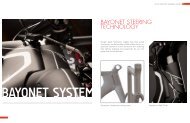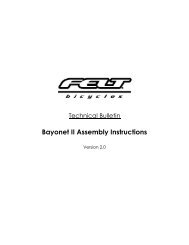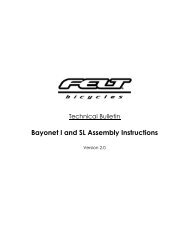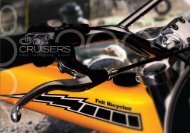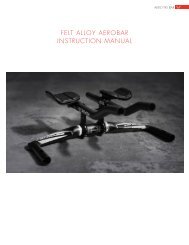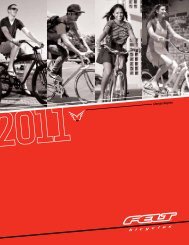Bicycle Owners Manual - Felt Bicycles
Bicycle Owners Manual - Felt Bicycles
Bicycle Owners Manual - Felt Bicycles
You also want an ePaper? Increase the reach of your titles
YUMPU automatically turns print PDFs into web optimized ePapers that Google loves.
1. Brake controls and features<br />
It’s very important to your safety that you learn and<br />
remember which brake lever controls which brake on<br />
your bike. Traditionally, the right brake lever controls<br />
the rear brake and the left brake lever controls the front<br />
brake; but, to make sure your bike’s brakes are set up<br />
this way, squeeze one brake lever and look to see which<br />
brake, front or rear, engages. Now do the same with the<br />
other brake lever.<br />
Make sure that your hands can reach and squeeze<br />
the brake levers comfortably. If your hands are too<br />
small to operate the levers comfortably, consult your<br />
dealer before riding the bike. The lever reach may be<br />
adjustable; or you may need a different brake lever<br />
design.<br />
Most rim brakes have some form of quick-release<br />
mechanism to allow the brake pads to clear the tire<br />
when a wheel is removed or reinstalled. When the<br />
brake quick release is in the open position, the brakes<br />
are inoperative. Ask your dealer to make sure that you<br />
understand the way the brake quick release works on<br />
your bike (see figs. 12, 13. 14 & 15) and check each<br />
time to make sure both brakes work correctly before you<br />
get on the bike.<br />
2. How brakes work<br />
The braking action of a bicycle is a function of the<br />
friction between the braking surfaces. To make sure that<br />
you have maximum friction available, keep your wheel<br />
rims and brake pads or the disk rotor and caliper clean<br />
and free of dirt, lubricants, waxes or polishes.<br />
Brakes are designed to control your speed, not<br />
just to stop the bike. Maximum braking force for each<br />
wheel occurs at the point just before the wheel “locks<br />
up” (stops rotating) and starts to skid. Once the tire<br />
skids, you actually lose most of your stopping force<br />
and all directional control. You need to practice slowing<br />
and stopping smoothly without locking up a wheel.<br />
The technique is called progressive brake modulation.<br />
Instead of jerking the brake lever to the position where<br />
you think you’ll generate appropriate braking force,<br />
squeeze the lever, progressively increasing the braking<br />
force. If you feel the wheel begin to lock up, release<br />
pressure just a little to keep the wheel rotating just<br />
short of lockup. It’s important to develop a feel for the<br />
amount of brake lever pressure required for each wheel<br />
at different speeds and on different surfaces. To better<br />
understand this, experiment a little by walking your bike<br />
and applying different amounts of pressure to each brake lever, until the wheel<br />
locks.<br />
When you apply one or both brakes, the bike begins to slow, but your body<br />
wants to continue at the speed at which it was going. This causes a transfer of<br />
weight to the front wheel (or, under heavy braking, around the front wheel hub,<br />
which could send you flying over the handlebars).<br />
A wheel with more weight on it will accept greater brake pressure before<br />
lockup; a wheel with less weight will lock up with less brake pressure. So, as<br />
you apply brakes and your weight is transferred forward, you need to shift your<br />
body toward the rear of the bike, to transfer weight back on to the rear wheel;<br />
and at the same time, you need to both decrease rear braking and increase front<br />
braking force. This is even more important on descents, because descents shift<br />
weight forward.<br />
Two keys to effective speed control and safe stopping are controlling wheel<br />
lockup and weight transfer. This weight transfer is even more pronounced if<br />
your bike has a front suspension fork. Front suspension “dips” under braking,<br />
increasing the weight transfer (see also Section 4.F). Practice braking and weight<br />
transfer techniques where there is no traffic or other hazards and distractions.<br />
Everything changes when you ride on loose surfaces or in wet weather. It will<br />
take longer to stop on loose surfaces or in wet weather. Tire adhesion is reduced,<br />
so the wheels have less cornering and braking traction and can lock up with less<br />
brake force. Moisture or dirt on the brake pads reduces their ability to grip. The<br />
way to maintain control on loose or wet surfaces is to go more slowly.<br />
D. Shifting gears<br />
Your multi-speed bicycle will have a derailleur drivetrain (see 1. below),<br />
an internal gear hub drivetrain (see 2. below) or, in some special cases, a<br />
combination of the two.<br />
1. How a derailleur drivetrain works<br />
If your bicycle has a derailleur drivetrain, the gear-changing mechanism will<br />
have:<br />
• a rear cassette or freewheel sprocket cluster<br />
• a rear derailleur<br />
• usually a front derailleur<br />
• one or two shifters<br />
• one, two or three front sprockets called chainrings<br />
• a drive chain<br />
a. Shifting Gears<br />
There are several different types and styles of shifting controls: levers, twist<br />
grips, triggers, combination shift/brake controls and push-buttons. Ask your<br />
dealer to explain the type of shifting controls that are on your bike, and to show<br />
you how they work.<br />
The vocabulary of shifting can be pretty confusing. A downshift is a shift to<br />
a “lower” or “slower” gear, one which is easier to pedal. An upshift is a shift<br />
to a “higher” or “faster”, harder to pedal gear. What’s confusing is that what’s<br />
24 25




